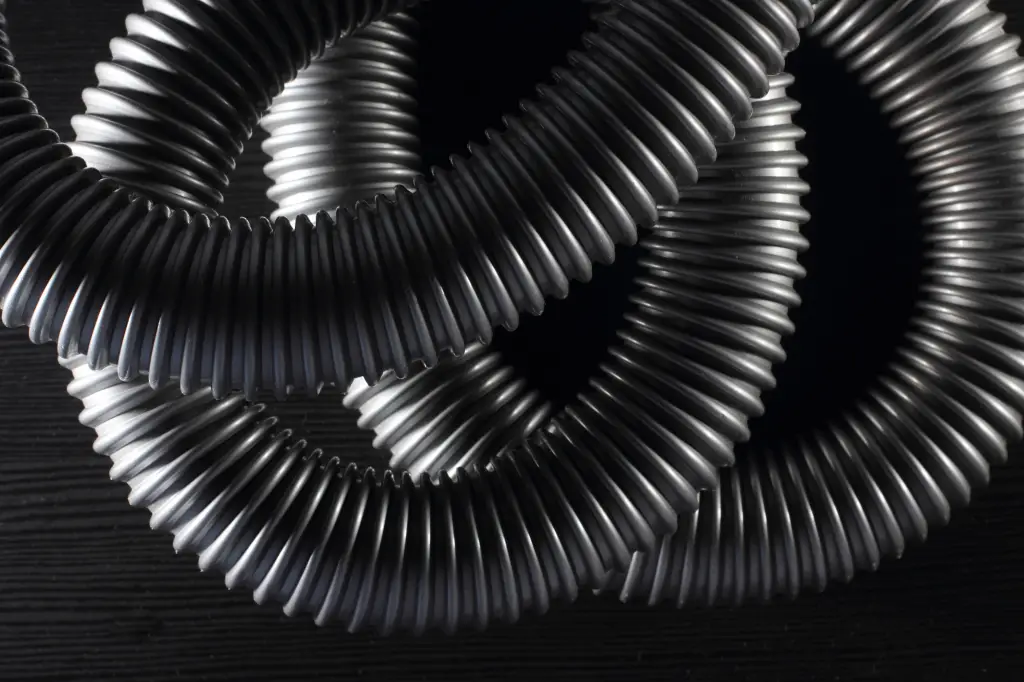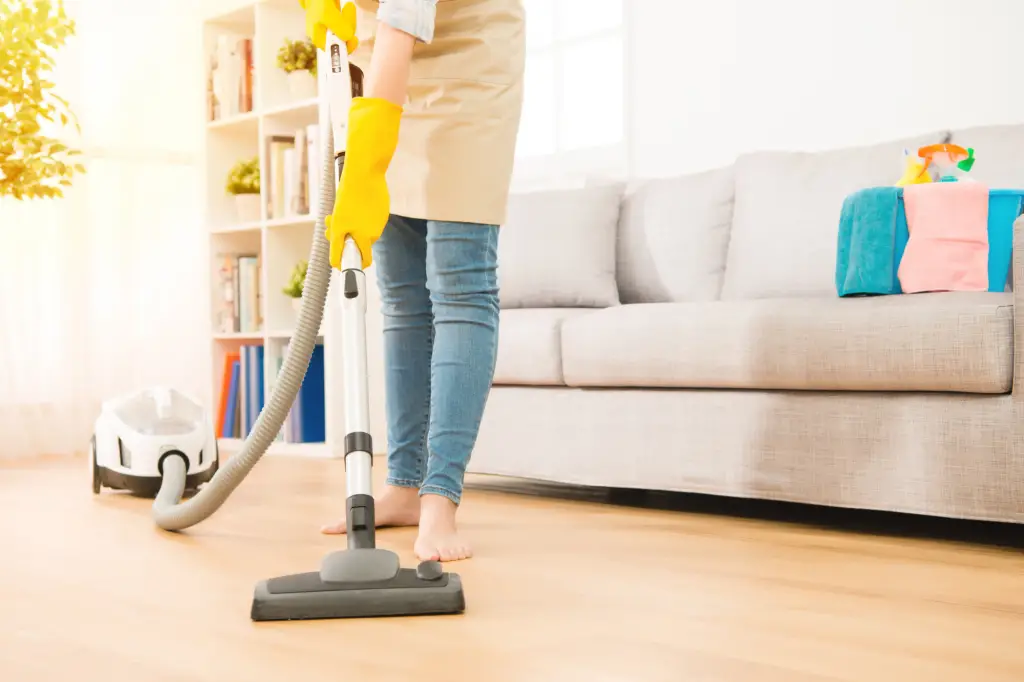Disclosure: This post contains affiliate links and I may earn a small commission if you purchase through these links.
Clogged pipes are problems in bathrooms, windpipes, and even in saxophones. But what is the most common clogged pipe you might encounter? Take a wild guess, you use this appliance every day to clean your home. That’s right. It’s your vacuum cleaner.
The secret to a spotless and welcoming home is a clean appliance that does its job. All it takes is a hot water rinse, a mild chemical for hardened grime, and a disinfectant liquid.
So how do you go about creating a spotless home? It starts with cleaning the hose of your vacuum

Where’s Waldo – um…the vacuum hose?
A standard vacuum cleaner has a handle, a waste collection bin, a suction bar that runs on the ground, and a hose.
Vacuum hoses are easy to identify because they are ribbed. Those used for cleaning homes are generally soft and flexible for reaching the tough spots: behind cabinets, under the bed, and behind your desk among the mess of wires.
But the hose might look a tad different if your vacuum is meant for the outdoors. It could be a solid pipe-like structure made of metal or rubber blended with carbon. It could be styrene-butadiene rubber or even ethylene-vinyl acetate! There is a variety of hoses designed for different types of debris ranging from glass to wood chips, liquids, and even fumes.
Generally, though, your vacuum hose is long, slender, and slithery, like a snake, no matter what its intended use. It is identifiable as a detachable part of the vacuum cleaner.
So you’ve identified the hose. Now what?
Let me tell you how to identify a hose in need of cleaning.
The need for damage control
How do you know when you are unwell?
You might feel feverish, or your throat might feel sore. You may start coughing. See how similar a vacuum hose is to us as people when it needs care?
A vacuum hose will likely do one of three things when it needs your attention or when it is damaged:
- It will start overheating soon upon use. This is noticeable since the heat will conduct to the handle. So, even if you aren’t touching or handling the hose, you will feel the heat at the handle. That’s its fever.
- It might sputter when you first turn it on, as though it’s coughing. This could indicate the presence of large debris. But, it could also be faulty mechanics that aren’t related to the hose at all. This means sputtering may not be the best standalone indicator of internal damage. Instead, you could use it to confirm damage with one or two of the other indicators.
- It will not suck up dirt the way it used to in the good old days. *sad face*. A lowered suction indicates a problem with the hose only if the past and present pressure are very different. A minor difference shows electrical fluctuations without damage inside the actual hose- at least without any damage that a little routine maintenance cleaning won’t fix.
Do you see the similarities between a sick human and an ailing vacuum hose? Yeah, I do too.
I’m going to show you how to fix this baby right up. But before I do, I need you to know what might have damaged it in the first place. Here are some common irritants for vacuum hoses.

Why does your vacuum hose get blocked?
Different vacuum cleaners have hoses with openings of differing diameters. This is because different hoses are made for different types of debris. And the texture isn’t the only distinguisher of debris. Particle size matters too.
A clogged vacuum hose is inevitable if you’ve been picking up particles bigger than its diameter. These may get through the opening because they are malleable or succumb to the air pressure. For instance, a vacuum meant for dust should not be used for plastic pellets.
Yet the size of the debris is also linked to the likelihood that the debris will decompose inside the hose.
We chew our food before it reaches our stomach. In a vacuum hose, things like hair and food waste get crushed or balled up before they move beyond the hose into the bin. These sticky things may attach themselves to the inner walls of the hose. They may become wedged between the ribbed joints of the pipe where the air pressure can’t pull them loose. In that case, you know your vacuum hose needs a cleaning.
Okay, okay, it’s finally time to look into some simple methods to clean your vacuum hose.
Look in your utility cupboard for some detergent, disinfectant, a slender brush with a long neck, and bleach or a mild drain-cleaning powder. Got ‘em? Let’s get cracking.

A simple solution to complex problems
We’ve seen the different ways in which your vacuum hose can get dirty or damaged. But you might be surprised to know there is one method to clean the hose no matter what the cause.
Here’s how:
We’re going to begin by detaching the hose, but first, disconnect the vacuum cleaner from any live electrical points it may be plugged into. This will ensure you don’t get shocked. You can also wear a pair of rubber slippers for extra protection.
After disconnecting the vacuum from the main plug point, detach the vacuum hose from the vacuum cleaner’s body.
After that, use a long brush, perhaps a bottle cleaning brush, or even a toothbrush, to free the extra debris and dirt from inside the hose. This process could be ugly depending on what your vacuum has been cleaning (if you find remnants of food, ew!). You can spread a newspaper or plastic sheet on the floor and clean the hose on top of that.
Now that the dry waste is out, we can clean the tougher grime.
We’re going to start by filling a large sink or washbasin with lukewarm water to soak the hose.
There are two ways you can execute this step. You can choose to soak the pipe in plain water and scrub off all the loose grime and debris from inside. Or, you can fill the sink with a liquid detergent to make the water soapy.
Using plain water may allow you to better see the waste you’re washing off so you will know what to avoid taking up with your vacuum cleaner. After using plain water, use bleach or the mild drain-cleaner you picked out to scrub the inside with a washcloth or soft scrub.
Please wear gloves while using bleach or drain cleaner to clean the vacuum hose. These compounds can be corrosive to skin, not just sensitive skin, so avoid bringing them into direct contact with your skin.
But you may not need to use drain cleaner or bleach at all! These are good to use only if your vacuum hose has caked-on waste in it that needs to be broken down chemically. Such waste could include clumps of hair, dried synthetic materials like paint or makeup, and food.
Let’s say your vacuum hose doesn’t have any of that. Lucky you! Fewer steps in the cleaning process. In that case, go with the second option of soaking your pipe in soapy water. I prefer liquid detergent because it is less slimy than powdered detergent, so it doesn’t slip as much.
I avoid using scented detergent because the mixed smells of detergent combined with waste inside the vacuum bin can result in a nasty smell overall. I’m no perfumer, and I know I don’t want that nasty smell in my house!
We’re not done just yet! For both a soapy rinse and a bleach cleaning, the final step is a water rinse.
You can wash the same basin you used for the first rinse and soak the hose in plain water. Or you could hold the opening of the hose under running water for 10-20 seconds. The important thing here is to ensure there is no residue from the soap, bleach, or drain cleaner. These could interfere with the working of the vacuum cleaner even after the hose has dried.
And that brings us to the last step before drying. Rinse the hose with a disinfectant. That’s it.
Once that’s done, remove the excess liquid from the pipe and let it dry.
Once the hose is dry, you can attach it back to the main vacuum. The suction should be much better than before. Now you can go back to cleaning and have that spick and span home you’ve always dreamed of!
But wait! How often should you clean your vacuum hose?
I’ll be honest with you. There’s no definite answer to that. I only clean my vacuum hose once every few months. That’s because I’m careful about which type of hose I use. Did I mention that using the same hose for too many types of waste can be damaging to the hose?
There are a lot of different vacuum hoses out there on the market. Some come as changeable attachments for the same vacuum cleaner. Others fit a different vacuum cleaner altogether. I’d recommend choosing a couple of hoses that best support your household needs. Once you’ve done that, you can determine how often they need to be cleaned.
I’ll say it again: it’s a personal choice! How often you choose to clean your vacuum hose is up to you. I’m sure you’ll do a wonderful job cleaning your vacuum hose and thriving in the upkeep of your cozy home!
Let’s recap before we say goodbye.
- Locate the hose of your vacuum cleaner. It is the ribbed, long, and slender part.
- Turn off all power outlets before detaching the hose.
- Soak the hose in a shallow sink or washbasin in lukewarm plain or soapy water.
- If you use plain water for the rinse, use bleach or a mild drain-cleaner to clean tough grime.
- If you use soapy water for the rinse, follow with a gentle scrubbing using a washcloth or soft dish scrub.
- Complete the process with a final, thorough rinse with water. The best method might be to run water through the hose for a few seconds.
- Let the hose air dry completely before reattaching it to the vacuum cleaner. Remember to keep the vacuum disconnected from electrical outlets while attaching the hose.
I hope you enjoy cleaning your vacuum hose as much as I do. The sound of a smooth vacuum and the look of a clean hose make my day!
Further Reading
